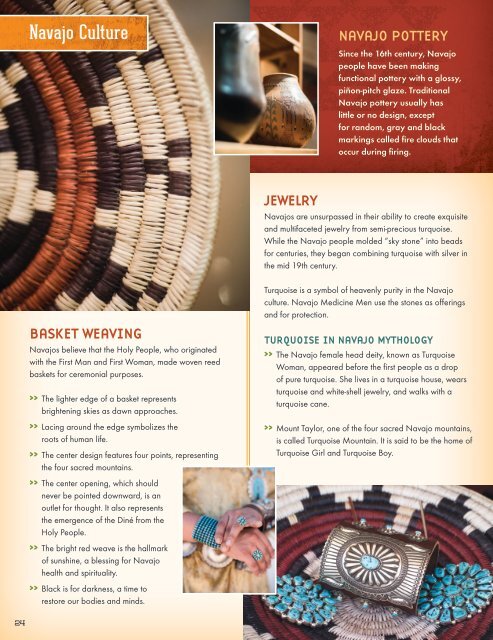You also want an ePaper? Increase the reach of your titles
YUMPU automatically turns print PDFs into web optimized ePapers that Google loves.
Navajo Culture<br />
NAVAJO POTTERY<br />
Since the 16th century, Navajo<br />
people have been making<br />
functional pottery with a glossy,<br />
piñon-pitch glaze. Traditional<br />
Navajo pottery usually has<br />
little or no design, except<br />
for random, gray and black<br />
markings called fire clouds that<br />
occur during firing.<br />
JEWELRY<br />
Navajos are unsurpassed in their ability to create exquisite<br />
and multifaceted jewelry from semi-precious turquoise.<br />
While the Navajo people molded “sky stone” into beads .<br />
for centuries, they began combining turquoise with silver in<br />
the mid 19th century.<br />
BASKET WEAVING<br />
Navajos believe that the Holy People, who originated<br />
with the First Man and First Woman, made woven reed<br />
baskets for ceremonial purposes.<br />
>> The lighter edge of a basket represents .<br />
brightening skies as dawn approaches.<br />
>> Lacing around the edge symbolizes the .<br />
roots of human life.<br />
>> The center design features four points, representing<br />
the four sacred mountains.<br />
Turquoise is a symbol of heavenly purity in the Navajo<br />
culture. Navajo Medicine Men use the stones as offerings .<br />
and for protection.<br />
TURQUOISE IN NAVAJO MYTHOLOGY<br />
>> The Navajo female head deity, known as Turquoise<br />
Woman, appeared before the first people as a drop<br />
of pure turquoise. She lives in a turquoise house, wears<br />
turquoise and white-shell jewelry, and walks with a<br />
turquoise cane.<br />
>> Mount Taylor, one of the four sacred Navajo mountains,<br />
is called Turquoise Mountain. It is said to be the home of<br />
Turquoise Girl and Turquoise Boy.<br />
>> The center opening, which should<br />
never be pointed downward, is an<br />
outlet for thought. It also represents<br />
the emergence of the Diné from the<br />
Holy People.<br />
>> The bright red weave is the hallmark<br />
of sunshine, a blessing for Navajo<br />
health and spirituality.<br />
>> Black is for darkness, a time to .<br />
restore our bodies and minds.<br />
24


